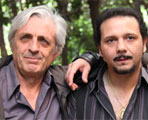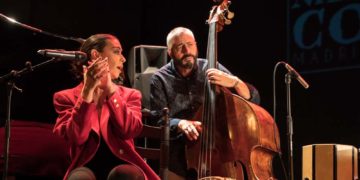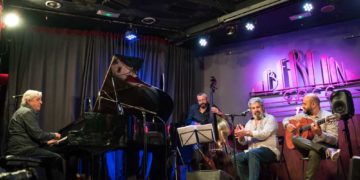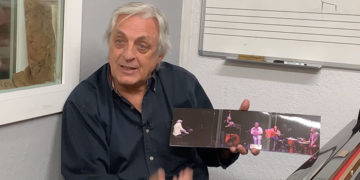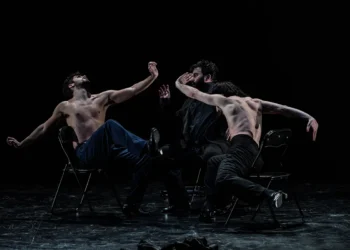Interview: Pablo San Nicasio
«We've managed to cross two musical languages in a natural way»
|
Putting together a group seems to be a viable option nowadays in these difficult economic times. If you add to this the popularity of jazz among new interpreters of flamenco, the current socio-musical trend is well-defined. We’ve gone from a few modest experiments with well-known names, to a new musical ethic nearly everyone has adopted, and which is on the way to becoming a genre in its own right within the great sea of flamenco. We’re talking about Pedro Ojesto, David Cerreduela and José Miguel Guzmán, three of the six musicians who make up Flamencojazz Company, a new group that has debuted with “Nikela”, according to them, a record that strikes the perfect equilibrium between flamenco and jazz. Suitable for anyone who is minimally open-minded. I’m always fascinated how jazz is the only music ideal for mixing with flamenco Pedro: Because jazz is a democratic formula for evolution. El “Gali” (José Antonio Galicia) used to explain it very well, he convinced a few of us that it was practical to bring these two musics together. And it’s true that we’re “foreigners” for a jazz purist, especially if we take into account that we didn’t come from a cotton plantation [laughter]. But if that was how it went, very few people would play any instrument, in any style at all. Jazz is a root music, and that’s why it gets along so well with flamenco, which is also a root music. José Miguel: And flamenco adapts very well to what jazz asks of it, and vice versa. For example, I ask David Cerreduela to improvise on a theme I give him: but what should I do? And without his realizing it, things start to come out, and he sees that the common ground is staggering. And after a month, you start seeing how David has the jazz phrasing engrained in his head. Does that mean it’s not flamenco any more? Well no, even though it drives the purists crazy. David: I knew how to organize my head and not get lost. [Laughter] But there are other root musics Pedro: But jazz is at the center, the rest are sort of like its satellites. You can play Indian music in a jazz style. I have a friend who directs a renaissance chorus, and he works the music in a jazz way, with his American wiring. That’s exactly what’s beginning to happen in flamenco. So is that fusion? Pedro: Well, the word “fusion”…yes…it’s a label that leads to confusion. But let’s see, my grandfather was Manolo Caracol’s throat doctor, and Sabicas came to our house…and what happened, well I began taking on flamenco, but I’m part of the jazz philosophy, because the jazz formula is about getting along together. There’s nothing wrong with uniting things like that, even Carlos Saura himself says so: “Flamenco is a music that was born from the fusion of other kinds of music”. So is it right to talk about a new musical genre? Pedro: Yes, flamencojazz. But it’s not new. Pedro Iturralde hooked up with Paco de Lucía, there was the kind of interaction we have now. And then they went on to Jorge Pardo, Benavent, me…but by the same token I can tell you flamencojezz hasn’t evolved much yet. Why? Because not many jazz musicians know how to play soleá, and not many flamenco musicians have the jazz swing or know how to read the music…it will be possible in the future, but there’s still not much. José Miguel: What I do see is people want to open up to jazz. So you consider it practical for a musician to be perfectly fluent in two different genres? José Miguel: To deny that would be to let many conservatory teachers’ obsolete philosophy win. As far as I’m concerned, that’s a fundamental error. Getting the basics is very important, but you can do that at home and be just as good, like David and his son who learned at home, and who would dare to say they don’t play flamenco? Pedro: Take Paco de Lucía for example. He’s much better at playing flamenco than jazz, this is clear. But when he plays jazz for jazz musicians, theirs jaws drop. The open-minded ones of course, not the stubborn ones. They might criticize Paco de Lucía, but then they name the town’s music conservatory after him. I’ve been around for thirty years, everyone knew I played jazz, but they couldn’t stand that I would put the sound of castanets in a show I did at the Teatro Pavón, for some music that was very Falla-oriented, and the castanets were just right. Well they couldn’t stand that. That kind of closed-mindedness by traditionalists, or even jazz musicians, is more European than American. “Take Paco de Lucía for example. He’s much better at playing flamenco than jazz, this is clear. But when he plays jazz for jazz musicians, theirs jaws drop. The open-minded ones of course, not the stubborn ones. They might criticize Paco de Lucía, but then they name the town’s music conservatory after him.” In the booklet it says you come from Pedro’s quintet, but you’re more than five. What are the origins? Pedro: We didn’t used to do so much flamenco when we took off from the trio of percussion-double bass-piano. Then I met David Cerreduela on Negri’s record, the tribute album to Agustín Lara. José Miguel: Then we were all together on Israel’s record, one of our singers, and the rapport was amazing. We said: “let’s make a cooperative, no?” In recession times when there aren’t so many gigs, what we have to do is join forces and play, create, not just sit home resigned. Especially when the whole thing works as good as this. Juan Antonio Salazar’s part is super interesting. What is it about him? Pedro: Actually, you have to consider Juan Antonio just another member of the group. But the thing is…we don’t know where he is. Seriously, we lost track of him…sometimes we call him and he’s reachable, and we’re lucky enough that he does some songs for us. He did stuff for Camarón, who was also enthralled with him. There aren’t many in flamenco who know how to write songs that grab people and that are up-to-date…there really are very few. José Miguel: He suggested some things we loved. We ought to be making a record with him, but like Pedro says, we have no idea where he is. David: I don’t understand how there can be someone so good. He Guadiana’s cousin, family of the Porrinas, that talent runs in the family. His harmony is incredible, and the fact is all you have to do is ask, and he always comes back with something fantastic. “If a flamenco hears this, they’ll see things that couldn’t be more flamenco. But if a Herbie Hancock fan listens to it, he won’t get lost either”. What’s “Nikela”? José Miguel: It’s something just occurred to me. A simple direct word that sounds gypsy, but isn’t. I’m sure it suggests nickel, something with that finish. Pedro: We have to thank the Fundación Orange, our benefactor, if it weren’t for them, I don’t think this would ever have come about. I’m fascinated by the balance between the various musicians Pedro: Yes, I think each one adds a lot but no one more than anyone else. Me for example, I do my own experiments, in my groups, but here everyone contributes in an even-handed way. One of the things that makes me proud is if a flamenco hears this, they’ll see things that couldn’t be more flamenco. But if a Herbie Hancock fan listens to it, he won’t get lost either… no doubt about it. And that balance is always there, even when the singers come in, for example, each one chooses the songs he feels most comfortable with. Let’s go piece by piece… José Miguel: It’s important to know that we had no plan in the beginning. Not to make a single, nor to make a jazzy solo, or a certain technique… We put together everyone’s opinion, and this is what came out, here and now. And covering as much different ground as possible. The jaleos for example, it’s a different flamenco color not much worked nowadays. In fact I suggested “Colors” for the title of the record. Pedro: David has a piece, the tangos “Caracolillo”, and one of mine, “Yepa”. Both were done a long time ago, and we updated them. There’s also an adaptation of Miles Davis, and the rest are all songs. “A ti Mujer” is a piece that repeats nothing, not a chorus, nothing, it’s all changing straight through. “Eres tú la Melodía” is a verse by Miguel de la Tolea set to soleá por bulerías. “Mírame que Bailame” is Juan Antonio’s in part. The piece “Bohemio” was sung by Potito on his first record, when he was a child. And if you listen to the variation played by Paco and Benavent, we do a version of that… David: On that record there were eleven guitarists. Where is Potito these days? David: He’s singing with an evangelical group, that’s all he does now. José Miguel: What a musician, he has perfect pitch, although he doesn’t know it… Speaking of the tangos “Caracolillo”, they remind me of El Viejín, because of Montse, the verse, the “cañorroto” style… David: Yes, well, the evangelical group is everywhere. We counted on Montse because we knew her from a long time ago. I worked with her with Antonio Canales, she’s like a sister for me. José Miguel worked with her when they were with Joaquín Cortés…so I asked her for a tango verse, and no problem at all. “It’s a fusion that was already made, not something cooked up for the record, it’s quite cohesive, not thrown together in a few months. In that sense, purism does exist, if it exists at all…” What are your plans for the future, and if possible, explain to me what you have that other jazz flamenco or flamenco jazz groups dont… Pedro: We’re in the process of organizing presentations in France, Barcelona, Valencia and we’ll soon be at the Café Central in Madrid. You know, trying to get some momentum going… We can offer a show of flamenco jazz with dance, with everyone professional and ready to go. And with music that does right by flamenco and jazz. “It’s a fusion that was already made, not something cooked up for the record, it’s quite cohesive, not thrown together in a few months. In that sense, purism does exist, if it exists at all…” José Miguel: We’ve managed to find that twisted path between two idioms in a very natural way. In such a way that it can be easily understood by both kinds of professionals, as long as they’re open-minded of course. Is a more open attitude necessary in young flamencos?…like people under forty-five? There are fewer prejudices all the time. Just think, the first open-minded singer I met was Ramón “El Portugués”, he liked everything he heard in jazz. And that was years ago. You see everything, but generally speaking, things have advanced. It’s not over yet, because if it was we’d be dead, but it’s more opened up all the time. José Miguel: And Enrique Morente who said: “play whatever you want, period”. Pedro: He was the one who taught me what bulerías was. It’s a disaster he’s gone. David: I told my wife I wanted to be like him, and tried to look like him. He was incredibly incredible. Are there up and coming flamenco bass-players and pianists? José Miguel: Not really a whole lot, but there are people with the desire to learn and to open up to other kinds of music. Javier Colina, Pablo Martín Caminero…but there will certainly be many more.Pedro: There are people mentally prepared to play flamenco jazz on piano, but they’re not so interested in pure flamenco, you don’t see them showing much interest in that. And if they do, they never acknowledge it, it’s a little hard for them to take.
|



